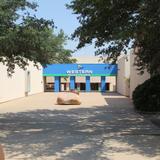- Texas State Technical College West Texas is a two-year higher education institution in Abilene, Breckenridge, Brownwood, and Sweetwater offering associate's degrees, certificates and customized training in critical and emerging technologies.
School Highlights
Texas State Technical College-West Texas serves 1,453 students (40% of students are full-time).
The college's student:teacher ratio of 20:1 is lower than the state community college average of 23:1.
Minority enrollment is 31% of the student body (majority Hispanic), which is less than the state average of 74%.
Quick Stats (2025)
- Enrollment: 1,453 students
- In-state tuition: $5,148
- Out-state tuition: $10,800
- Student:teacher ratio: 20:1
- Minority enrollment: 31%
- Source: Integrated Postsecondary Education Data System (IPEDS)
Top Rankings
Texas State Technical College-West Texas ranks among the top 20% of public schools in Texas for:
Category
Attribute
School Resources
School Overview
The teacher population of 73 teachers has stayed relatively flat over five years.
Texas State Technical College-West Texas
(TX) Community College Avg.
Carnegie Classification
Associates Colleges
Baccalaureate/Associate's Colleges: Associate's Dominant
Institution Level
Less than 2 yrs
At least 2 but less than 4 years
Institution Control
Public
Private, for profit
Total Faculty
73 staff
262 staff

School Calendar
Student Body
The student population of Texas State Technical College-West Texas has stayed relatively flat over five years.
The student:teacher ratio of 20:1 has stayed the same over five years.
The Texas State Technical College-West Texas diversity score of 0.47 is less than the state average of 0.70. The school's diversity has stayed relatively flat over five years.
Total Enrollment
1,453 students
1,396 students

Student : Teacher Ratio
20:1
23:1

# Full-Time Students
579 students
890 students

# Part-Time Students
874 students
4,022 students



# Enrollment Undergraduate
964 students
403 students
# Full-Time Undergraduate Students
579 students
890 students

# Full-Time Graduate Students
n/a
40 students
# Part-Time Undergraduate Students
n/a
4,022 students
# Part-Time Graduate Students
n/a
47 students
Total Dormitory Capacity
n/a
252 students

% American Indian/Alaskan
1%
n/a

% Asian
1%
6%

% Hispanic
23%
46%

% Black
4%
14%

% White
69%
26%

% Two or more races
n/a
3%

% Non Resident races
n/a
2%
% Unknown races
2%
3%


Diversity Score
0.47
0.70

College Completion Rate (Students who graduate in less than 4 years)
31%
19%

College Completion Rate (Students who graduate in 4 years or more than 4 years)
n/a
0.3357%
Average Graduate Earnings (10 Years)
$35,000
$34,600

Tuition and Acceptance Rate
The public in-state tuition of $5,148 is more than the state average of $3,316. The in-state tuition has stayed relatively flat over four years.
The public out-state tuition of $10,800 is more than the state average of $5,750. The out-state tuition has stayed relatively flat over four years.
In-State Tuition Fees
$5,148
$3,316

Out-State Tuition Fees
$10,800
$5,750

% Students Receiving Some Financial Aid
100%
84%

Median Debt for Graduates
$9,168
$9,584

Median Debt for Dropouts
$5,500
$5,250

Acceptance Rate
n/a
81%
Source: 2023 (or latest year available) Integrated Postsecondary Education Data System (IPEDS)
School Notes
- Texas State Technical College (TSTC), then James Connally Technical Institute (JCTI), was created in 1965 by the Legislature to meet the evolving work force needs of Texas business and industry. The looming need for a special institute for technicians had been a pressing issue for state leaders, and the soon-to-be abandoned James Connally Air Force Base in Waco was the ideal location for the top-quality technical institute they had planned. Governor John Connally predicted the institute would be, the most sophisticated technical-vocational institute in the country. Situated on sixty-five acres, Texas State Technical College West Texas, Sweetwater Campus, has thirteen instructional buildings, all of which have been built or extensively remodeled since the college opened in 1970. Student housing for 216 individual students exists on the Sweetwater Campus in the form of apartments and dorms. Recreational facilities include The Center, which houses a Cardiovascular Fitness Center, a Strength Training Center, table tennis, billiards and a student lounge with satellite TV. Outside, there are volleyball, basketball and tennis courts, a baseball diamond, a covered pavillion, and a recreational site at Lake Sweetwater. TSTC West Texas is part of the Texas State Technical College System, a public coeducational institution of higher education offering courses of study in technical education leading to the award of Certificates and Associate of Applied Science degrees. Texas State Technical College's high graduation rate, established relationship with business and industry, and state-of-the-art laboratories are providing productive and responsible graduates for employers across Texas. Texas State Technical College West Texas is accredited by the Commission on Colleges of the Southern Association of Colleges and Schools to award Associate of Applied Science degrees and Certificates of Completion.
Frequently Asked Questions
How much does Texas State Technical College-West Texas cost?
Texas State Technical College-West Texas's tuition is approximately $5,148 for In-State students and $10,800 for Out-State students.
What is Texas State Technical College-West Texas's ranking?
Texas State Technical College-West Texas ranks among the top 20% of community college in Texas for: Percent of students receiving financial aid.
Recent Articles

Obtaining Your Bachelor's Degree at a Community College
Explore the evolving landscape of community colleges offering bachelor's degrees, addressing affordability, accessibility, and workforce needs.

A to Z of Community College Certificates and Courses
From business and healthcare to technology and skilled trades, the article showcases the breadth of options available to students seeking to enhance their knowledge, develop new skills, or pursue career advancement.

What is a Community College?
This comprehensive guide explains what a community college is, its history, and its role in higher education. It covers the types of programs offered, differences from four-year colleges, benefits of attending, and important considerations for prospective students, providing valuable insights for those exploring educational options.








